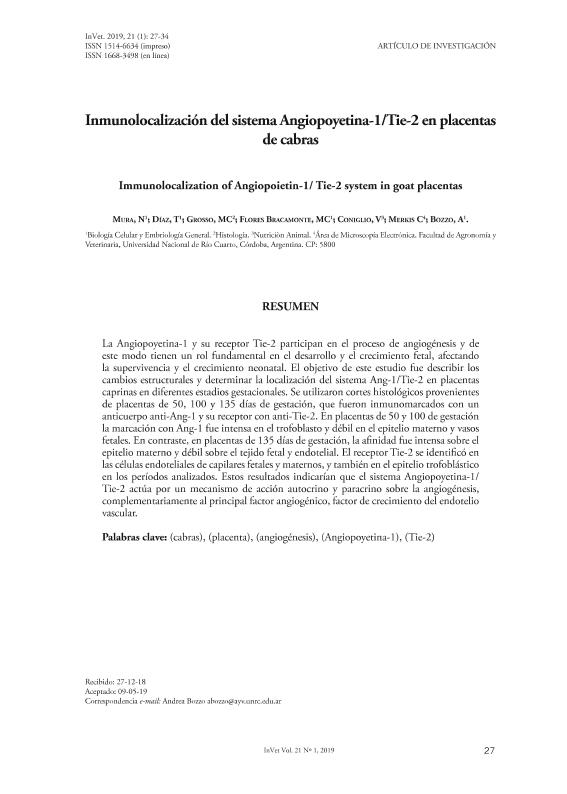Artículo
La Angiopoyetina-1 y su receptor Tie-2 participan en el proceso de angiogénesis y de este modo tienen un rol fundamental en el desarrollo y el crecimiento fetal, afectando la supervivencia y el crecimiento neonatal. El objetivo de este estudio fue describir los cambios estructurales y determinar la localización del sistema Ang-1/Tie-2 en placentas caprinas en diferentes estadios gestacionales. Se utilizaron cortes histológicos provenientes de placentas de 50, 100 y 135 días de gestación, que fueron inmunomarcados con un anticuerpo anti-Ang-1 y su receptor con anti-Tie-2. En placentas de 50 y 100 de gestación la marcación con Ang-1 fue intensa en el trofoblasto y débil en el epitelio materno y vasos fetales. En contraste, en placentas de 135 días de gestación, la afinidad fue intensa sobre el epitelio materno y débil sobre el tejido fetal y endotelial. El receptor Tie-2 se identificó en las células endoteliales de capilares fetales y maternos, y también en el epitelio trofoblástico en los períodos analizados. Estos resultados indicarían que el sistema Angiopoyetina-1/Tie-2 actúa por un mecanismo de acción autocrino y paracrino sobre la angiogénesis, complementariamente al principal factor angiogénico, factor de crecimiento del endotelio vascular. Angiopoietin-1 and Tie-2 receptor participate in the process of angiogenesis and thus plays a critical role in fetal growth and development, affecting neonatal survival and growth. The objective of this study was to describe the structural changes and determine the location of the Angiopoietin-1/Tie-2 system in goat placentas at different gestational stages. Histological sections from placentas of 50, 100 and 135 days of gestation were used. This were immunolocatization with an anti-Ang-1 antibody and with anti-Tie-2. Ang-1 was evidenced in the trophoblastic epithelium in intense form in placentas of 50 and 100 days of gestation and in a weaker form in the maternal epithelium and fetal blood vessels. In contrast, in placentas of 135 days of gestation, the immunolocatization was intense on the maternal epithelium and weak on the fetal and endothelial tissue. The Tie-2 receptor was located in the endothelial cells of fetal and maternal capillaries and in the trophoblastic epithelium in the periods analyzed. This would indicate that the Angiopoietin-1/Tie-2 system acts by an autocrine and paracrine mechanism of action on angiogenesis, in addition to the main angiogenic factor, vascular endothelial growth factor.
Inmunolocalización del sistema Angiopoyetina-1/Tie-2 en placentas de cabras
Título:
Immunolocalization of Angiopoietin-1/ Tie-2 system in goat placentas
Mura, Nadya Micaela ; Diaz, Tomas; Grosso, Maria Carolina
; Diaz, Tomas; Grosso, Maria Carolina ; Flores Bracamonte, María Carolina
; Flores Bracamonte, María Carolina ; Coniglio, Valeria; Merkis, Cecilia Inés; Bozzo, Aida Andrea
; Coniglio, Valeria; Merkis, Cecilia Inés; Bozzo, Aida Andrea
 ; Diaz, Tomas; Grosso, Maria Carolina
; Diaz, Tomas; Grosso, Maria Carolina ; Flores Bracamonte, María Carolina
; Flores Bracamonte, María Carolina ; Coniglio, Valeria; Merkis, Cecilia Inés; Bozzo, Aida Andrea
; Coniglio, Valeria; Merkis, Cecilia Inés; Bozzo, Aida Andrea
Fecha de publicación:
08/2019
Editorial:
BMPress
Revista:
Invet
ISSN:
1514-6634
e-ISSN:
1668-3498
Idioma:
Español
Tipo de recurso:
Artículo publicado
Clasificación temática:
Resumen
Palabras clave:
CABRAS
,
PLACENTAS
,
ANGIOGÉNESIS
,
ANGIOPOYETINA-1
,
TIE-2
Archivos asociados
Licencia
Identificadores
Colecciones
Articulos(CCT - CORDOBA)
Articulos de CTRO.CIENTIFICO TECNOL.CONICET - CORDOBA
Articulos de CTRO.CIENTIFICO TECNOL.CONICET - CORDOBA
Citación
Mura, Nadya Micaela; Diaz, Tomas; Grosso, Maria Carolina; Flores Bracamonte, María Carolina; Coniglio, Valeria; et al.; Inmunolocalización del sistema Angiopoyetina-1/Tie-2 en placentas de cabras; BMPress; Invet; 21; 1; 8-2019; 33-44
Compartir



